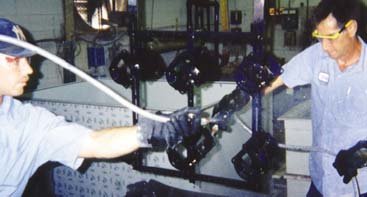Electroplating Effluent Guidelines

The EPA promulgated the Electroplating regulation (40 CFR Part 413) in 1974 and amended it in 1977, 1979, 1981 and 1983. The regulation applies to certain facilities that discharge their wastes to POTWs. The requirements are incorporated into permits or other control mechanisms for indirect dischargers (refer to Pretreatment Program).
On this page:
- What is Electroplating?
- Current Rulemaking for Chrome Finishing Facilities
- Existing Rule - Facilities Covered
- Guidance and Related Documents
- Regulatory History
- Additional Information
What is Electroplating?
Electroplating applies a surface coating (typically by electrodeposition) to provide corrosion protection, wear or erosion resistance, anti-frictional characteristics or for decorative purposes. The electroplating of common metals includes the processes in which a ferrous or nonferrous basis material is electroplated with copper, nickel, chromium, zinc, tin, lead, cadmium, iron, aluminum or combinations thereof. Precious metals electroplating includes the processes in which a ferrous or non-ferrous basis material is plated with gold, silver, palladium, platinum, rhodium, or combinations thereof.
Current Rulemaking for Chrome Finishing Facilities
Following announcement in the Preliminary Effluent Guidelines Program Plan 15 (September 2021), the EPA is conducting a rulemaking to address per- and polyfluoroalkyl substances (PFAS) discharges from a subset of facilities in the Metal Finishing and Electroplating point source categories. Based on information and data collected during the Multi-Industry PFAS Study, the EPA determined PFAS are used by some metal finishing and electroplating facilities to control hexavalent chromium emissions, a known human carcinogen and inhalation hazard. The EPA determined facilities performing certain chromium operations, hereafter referred to as “chrome finishing facilities,” including chromium plating, chromium anodizing, chromic acid etching, and chromate conversion coating operations, are the predominant sources of PFAS discharges by the Metal Finishing and Electroplating point source categories.
All supporting materials for the rulemaking can be found at the EPA's docket at regulations.gov. The Docket Number is EPA-HQ-OW-2022-0869.
Existing Rule - Facilities Covered
The regulation applies to processes that apply metallic coatings on surfaces by electrodeposition, and that were in operation before July 15, 1983, at facilities that discharge their wastes to POTWs. This includes both independent (job) platers and captive operations associated with product fabrication and assembly.
- Click to enlarge
Note: Processes that began operating on or after that date, at indirect dischargersA facility that discharges pollutants to a publicly owned treatment works (municipal sewage treatment plant)., are subject to the Metal Finishing category, 40 CFR Part 433. All direct dischargingA point source that discharges pollutants to waters of the United States, such as streams, lakes, or oceans. electroplaters are also covered by the Metal Finishing category.
The plants covered by the Electroplating regulations are found throughout the United States but are concentrated in heavily industrialized areas. The pretreatment standards apply to facilities in seven subcategories:
- Common Metals (Subpart A)
- Precious Metals (Subpart B)
- Anodizing (Subpart D)
- Coatings (Subpart E)
- Chemical Etching and Milling (Subpart F)
- Electroless Plating (Subpart G)
- Printed Circuit Board (Subpart H)
The electroplating of specialty metals (Subpart C) is a currently reserved subcategory.
Regulated pollutants
The standards have specific numerical limitations for each subcategory, and are imposed on pollutants which may interfere with, pass through, or otherwise be incompatible with POTWs. For plants with a daily flow of 38,000 liters (10,000 gallons) per day or more, the pretreatment standards specifically limit indirect discharges of cyanide and the following metals: lead, cadmium, copper, nickel, chromium, zinc, and silver. Additionally, these regulations limit "total metal discharge," which is defined as the sum of the individual concentrations of copper, nickel, chromium and zinc. For plants with a daily process wastewater flow of less than 38,000 liters (10,000 gallons), these standards limit only lead, cadmium, and cyanide.
Guidance and Related Documents
- Download the publications
- Regulatory Determination for the "PreKote" Surface Preparation Process (April 2003)
- Information on the Misuse of Sodium Dimethyldithiocarbamate (Memorandum, June 2000)
- Guidance Manual for Implementing Total Toxic Organics (TTO) Pretreatment Standards (September 1985)
- Guidance Manual for Electroplating and Metal Finishing Pretreatment Standards (February 1984)
The guidance is useful to Control Authorities in responding to most routine inquiries from regulated manufacturers, including category determination requests. It includes a discussion of the Combined Wastestream Formula as it applies to integrated facilities.
Regulatory History
1983 Amendment
- Documents, including:
- Final Rule: Metal Finishing and Electroplating Categories (July 15, 1983)
- Proposed Rule: Metal Finishing and Electroplating Categories (August 31, 1982)
1981 Amendment
- Documents, including:
- Final Rule (January 28, 1981)
- Proposed Rule (July 3, 1980)
1979 Amendment
- Documents, including:
- Final Rule (September 7, 1979)
- Development Document
Industry description, wastewater characterization, treatment technologies, regulatory compliance cost estimates and pollutant loadings for the final rule
- Development Document
- Suspension of PSES (May 4, 1979)
- Proposed Rule (February 14, 1978)
- Final Rule (September 7, 1979)
1977 Amendment
- Documents, including:
- Interim Final Rule (July 12, 1977)
- Proposed Rule (April 24, 1975)
- Proposed Rule (March 28, 1974)
1976 Suspension
- Suspension of BPT (December 3, 1976)
1975 Amendment ("Phase II")
- Interim Final Rule (April 24, 1974)
1974 Initial Rulemaking ("Phase I")
- Final Rule (March 28, 1974)
- Proposed Rule (October 5, 1973)
Additional Information
For additional information regarding the current rulemaking to regulate the discharge of PFAS from chrome finishing facilities only, please contact Phillip Flanders (flanders.phillip@epa.gov) or 202-566-8323. For all other questions about the Electroplating Effluent Guidelines, please contact Ahmar Siddiqui (siddiqui.ahmar@epa.gov) or 202-566-1044.

